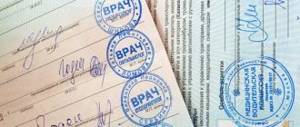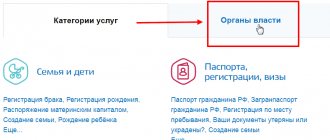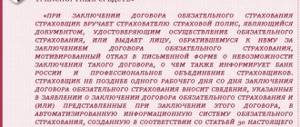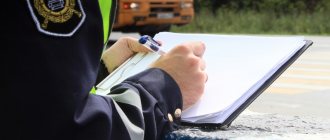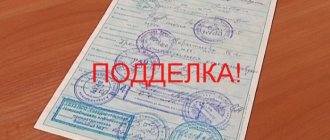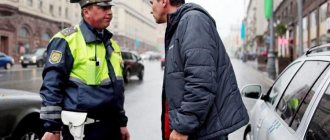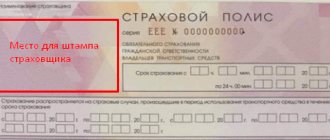- 1. What documents are needed after an accident? 1.1. If the incident is without casualties
- 1.2. If there are injured or dead
- 2.1. Is it possible to deliver the necessary papers later?
- 3.1. If there are no casualties
Important facts from the article
- The easiest way to have all the documents on hand at once for applying under compulsory motor liability insurance is to draw up a European protocol.
- If the notification is not issued without police officers, then the necessary papers for the accident will need to be obtained either from the traffic police or in court.
- The traffic police must consider a case of an offense within 15 days, and the court within 2 months, but alas, these deadlines can be extended.
- After an incident with injured or dead people, you can wait even a year and a half for the necessary documentation.
- But you can contact the insurance company without having a complete set of documents.
Drivers meet and communicate with traffic police inspectors when they are either checked or held accountable. That is, most drivers received the order right on the spot and continued to move about their business. It would seem that such a procedure should exist when registering an accident, because one of the drivers violated traffic rules, which means he just needs to issue a decree, and everyone will go about their business. Is this how things really are, or will we have to wait for documents after the incident, and then how long, and whether it is possible to speed up such a wait, we will look into this article.
What documents are needed after an accident?
Let us remember that not all road accidents are reported by traffic police officers. Most of them are settled by the drivers themselves on the spot. But when disputes cannot be avoided, or when more than 2 vehicles were involved in the accident, or the liability of one of the drivers is not insured, then inspectors will file the accident.
And the set of documents here depends on a number of circumstances:
- how many cars were involved in the accident - you will have to wait the least amount of time for documents from the traffic police if there were 2 cars and there were no injuries,
- are there any casualties in the incident,
- are there any dead?
If the incident is without casualties
The absence of victims is another condition under which it is possible to register an accident under the European OSAGO protocol. With this registration of the incident, it will be enough for the victim to have a notice of the accident, signed by both drivers, and other documents from the MTPL Rules. Documents from the traffic police are not required at all.
If it was not possible to file an accident in a simplified manner - for example, if there is a disagreement about guilt or circumstances in the incident, then you will have to call and wait for the traffic police officers.
After registering the incident, the victim will need to provide the insurance company with one or more documents from the list:
- ruling on refusal to initiate a case regarding the APN,
- administrative violation protocol,
- resolution on an administrative offense,
- decision to terminate the proceedings,
- the court's decision.
A resolution (from paragraphs 3 or 4) or a determination can be issued to you by the traffic police. Perhaps they will be given along with the protocol, if one was drawn up. But they cannot issue both a ruling and a resolution at once - only one is drawn up. Of course, if we are talking about one violation of the culprit.
And it is these documents that most often do not have to wait long - they are drawn up directly at the scene of the accident. But only if an administrative investigation was not ordered - for example, if the culprit disappeared.
If there are injured or dead
When submitting applications to the insurance company after an accident with victims, when both property and people were damaged, you will need to provide both the above documents, which are issued by the traffic police or the court (one or more), and certified papers for compensation for damage to health and compensation for lost earnings . The list of documents on harm to health is specified in paragraph 4.1 of the OSAGO Rules, and on lost earnings - in paragraph 4.2.
Thus, in addition to the ruling/ruling/protocol or court decision, the victim may need to receive payment:
- a report received from a hospital with a specific diagnosis, injury and/or degree of disability,
- forensic medical examination report,
- certificate of disability,
- a certificate from an ambulance, if it was at the scene of an accident,
- certificate of average monthly salary, scholarship, pension or other income,
- any other documents that can confirm your income - even if it is unofficial.
Regarding the last point, there is no need to worry: neither the insurance company nor the courts automatically transmit information to the tax office. Although, if there is an obvious suspicion of an attempt to hide income from taxation, the official is obliged to notify the supervisory authorities about this.
If someone is killed, then persons entitled to this will be able to apply for compensation; more details about them and the necessary documents are indicated in paragraph 4.4 of the OSAGO Rules.
When do you need to challenge a traffic accident certificate?
The situation on domestic highways continues to be tense. Statistics show that the number of road accidents in Russia is growing every year. There are a huge number of reasons for this phenomenon. Any road accident entails material losses, since cars are often damaged in accidents. As soon as a collision occurs, it is necessary to immediately call the traffic police to the scene. The police will record the accident and issue a certificate of accident. Unfortunately, as practice often shows, the data specified in the document may differ from reality. In such a situation, the parties to an accident are forced to look for information on how to appeal a certificate of an accident.
The road accident certificate, which is issued by traffic police at the scene of the collision, has a standard form approved by the Order of the Ministry of Internal Affairs dated April 1, 2011. Thus, the document must have a certain appearance. Only in this case can it be used further. Therefore, if you are involved in an accident in which your car was damaged, then you need to obtain a certificate of the accident. If for some reason it does not comply with current legal requirements, it contains errors or the situation is presented incorrectly, then it is necessary to appeal the certificate.
It is worth noting that the current legislative framework does not establish a procedure for appealing a certificate. Therefore, the term “appeal” itself should not be taken in its literal sense.
It is important to note that the road accident certificate is an official document on the basis of which the circumstances of the road collision and the involvement of one or another party in creating an unfavorable road situation will be determined. This document indicates all the data that will be required to exercise the rights and interests that are associated with compensation for material and moral damage, challenging the amount of compensation, etc.
In addition, a certificate of an accident is an integral part of any relationship with the insurance company. If you intend to receive an insurance payment, you will be required to provide this certificate to your insurance company.
Is it possible to contact the insurance company under compulsory motor liability insurance if you do not have all the documents?
The MTPL law does not contain any prohibitions on contacting the insurer with an incomplete set of documents if you have to wait until the traffic police prepares the missing ones. Therefore, of course, it is possible to submit not the entire list in this case.
If the documents are handed over by the victim or another authorized person in person, then the insurer’s representative is obliged to draw up an act of acceptance of the documents, which will indicate which papers were handed over. Also, on the day of application, the insurer must inform about what documents are missing to complete the complete set. This obligation is spelled out in paragraph 3.2 of Article 15 of the Law on Compulsory Motor Liability Insurance.
If sent by mail or courier, the list of documents must be reflected in the list of attachments in the postal item. After receiving your letter, the insurer is obliged to report the incomplete set within 3 business days, indicating the list of missing documents. This obligation is specified in paragraph 5 of paragraph 1 of Article 12 of the Law on Compulsory Motor Liability Insurance.
Is it possible to deliver the necessary papers later?
Certainly! The missing documents are not only possible, but will also need to be conveyed or sent to the insurer, otherwise he will decide to refuse insurance compensation. But even if he refuses, he will be obliged to return to considering your case after you provide a complete set of papers after you have received them from the traffic police.
From October 20, the traffic police will not issue a certificate of accident
On October 20, 2021, Order of the Ministry of Internal Affairs of Russia dated September 23, 2021 No. 664 “On approval of the Administrative Regulations for the execution by the Ministry of Internal Affairs of the Russian Federation of the state function of exercising federal state supervision over compliance by road users with the requirements of the legislation of the Russian Federation in the field of road safety” came into force. . The order was developed to replace the existing administrative regulations approved in 2009.
Termination of issuing certificates of road accidents
The provisions that provide for the issuance of a certificate of the accident by police officers to participants in the incident when registering an accident are excluded from the new administrative regulations.
That is, starting from today, when registering an accident, police officers will draw up exclusively procedural documents provided for by law. This, in particular, is a determination to initiate a case of an administrative offense and conduct an administrative investigation, or a protocol on an administrative offense, or a resolution on a case of an administrative offense. The primary procedural document will briefly reflect the information that was previously contained in the accident certificate (information about vehicles and their damage, MTPL insurance policies, participants in the accident).
Thus, a separate certificate of road accident will not be issued.
Stopping drivers by State Traffic Inspectorate officers to check documents
Due to the fact that the number of traffic police posts has decreased threefold in recent years, and the number of citizens driving cars without a license has increased, to ensure public safety it is necessary to strengthen control over the road network.
As is known, until today, a stop based solely on checking documents could only be carried out at a stationary traffic police post.
From October 20, 2021, it is possible to stop vehicles on this basis (that is, only for the purpose of checking documents) outside of stationary traffic police posts, that is, when officers are on duty both on foot and on patrol vehicles (cars, motorcycles).
To the previously existing grounds for an officer to stop a car outside a stationary traffic police post (detection of the fact that the driver violated traffic rules, the presence of indications about the involvement of the vehicle in the commission of an offense, the need to interview the driver or involve him as a witness to provide assistance, the need to use the vehicle and during special preventive and other measures) a basis was added regarding the verification of documents, which previously could only be applied at a stationary traffic police post.
Photo and video recording of communication with State Traffic Inspectorate employees
The new order on the work of the traffic police does not contain the provision that was in the previous order and prohibited State Traffic Inspectorate employees from preventing citizens from taking photographs and video recordings of interactions with employees.
Many motorists and experts interpreted this fact differently, from the position of excluding from the regulations the right of citizens to photograph and videotape the inspector.
The State Traffic Inspectorate explains: the inspector has no right to interfere with video recording
Restriction of such a right is possible within the framework of security or operational-search measures, consideration of a case of an administrative offense, as well as for the purpose of protecting state and other secrets protected by law, protecting the rights of citizens, public associations and organizations.
For example, if a driver films the scene of an accident on his phone and interferes with the inspector, he may demand that the filming be stopped. Or a counter-terrorist operation regime has been introduced in the region, in which case the traffic police officer must inform the driver about this and ask him to turn off the camera.
The inspector himself also has the right to film, not only on the office video recorder, but also on his own mobile phone.
Use of photo-video recording systems for traffic violations in repair work areas
The previous order did not allow the use of automatic restraints in places where traffic restrictions were established by temporary road signs.
Now automatic photo-video recording systems will be used on such sections of highways. This measure will reduce the number of accidents associated with drivers exceeding established temporary speed limits in areas where repair, reconstruction and improvement of the road network are being carried out.
A provision has been included on the possibility of using technical means that do not belong to internal affairs bodies
In connection with the introduction of National Standards from June 1, 2021, defining general technical requirements for automatic fixation means and the rules for their use, the regulations include provisions regarding the compliance of such means with these GOSTs.
When making a decision (concluding an agreement with organizations) on the use of newly commissioned automatic fixation means, the State Traffic Inspectorate will monitor the availability of information about their compliance with the requirements of GOST, which defines the General technical requirements for automatic fixation means.
As for GOST, which establishes the rules of application, its effect will apply to all complexes, including those put into operation earlier.
Changes in the procedure for testing for intoxication
The provisions concerning examination for intoxication are supplemented by a rule obliging a police officer (if the examination for intoxication is carried out at the nearest traffic police post or other premises of the internal affairs body) if the result of the examination for intoxication is negative and there are no grounds for sending him for a medical examination to state of intoxication, transport the person to the place of removal from driving a vehicle or to the location of his vehicle. The old regulations included a rule that obligated inspectors to return drivers to the car only after a medical examination from the hospital (if intoxication was not detected).
Technical amendments (bringing the provisions of the Regulations in accordance with current legislation)
Some of the changes are technical in nature and are not innovations as such. For example, the possibility of confiscating a driver’s license and removing license plates has been removed - these measures were previously (in 2013) already excluded from the legislation and are not applied. Now the inspector can be presented not only with a traditional paper OSAGO policy, but also with a printout of an electronic one (the corresponding law was adopted back in 2021). A procedure has been prescribed for registering an accident without the participation of witnesses, which has also been in effect since 2014. There was quite a lot of discussion about innovations supposedly related to covert patrolling. But in reality, nothing has changed: this form of traffic control was allowed before.
Information from the State Traffic Safety Inspectorate for the Tver region.
How much to wait?
Obtaining documents after an accident can be divided into 2 options:
- when all the necessary documents can be obtained directly from the traffic police,
- when the papers will need to be received (and most often wait) in court.
If there are no casualties
When no one was injured in an accident, it is mainly considered by traffic police officers. An exception will be cases when the violation of the perpetrator must be considered by the court. Article 23.1 of the Code of Administrative Offenses of the Russian Federation lists administrative offenses that are considered by the court.
Consideration of the case by inspection staff can also be divided into 2 cases:
- consideration of the case without an administrative investigation,
- with such an investigation.
If an administrative investigation into the case is not carried out, then it must be considered within fifteen days. But this is not the maximum period for waiting for documents from the traffic police. The specified period of 15 days can be extended, but not more than by a month.
The period of the administrative investigation is 1 month, but it can also be extended for another month. In practice, it is precisely 2 months that one has to wait for documents when conducting such an investigation. And it is very rarely possible to speed up this process.
After receiving all documents, the court is obliged to consider the case within 2 months. Plus 1 month for possible extension.
The most ideal option for the victim is when a traffic police officer reviews the case on the spot and issues documents in hand. This mainly happens when the second participant does not dispute his guilt and the circumstances of the incident. But sometimes employees simply do not have time to draw up all the papers on the spot, then registration of the accident and consideration of the case can be continued in the department.
If you are sent for a review, then you will receive the necessary documents only after the case has been considered, or at best, on the day of the review.
If there are victims
In this case, you can immediately forget about quickly obtaining documents regarding an accident. Despite the fact that Article 4.5 of the Code of Administrative Offenses states that a decision in a case cannot be made after 3 months from the date of the commission of the APN in a case considered by the court, in practice all this stretches out for about a year.
Therefore, in the case of victims, it is better to contact the insurer with an incomplete set of documents, so that he at least inspects the damaged car in order to record all existing damage from this accident.
Having caused a wave of discussions among motorists and experts, the new administrative regulations of the State Traffic Safety Inspectorate came into force on October 20, 2017. According to the document, traffic police officers can stop vehicles outside of stationary posts, not issue certificates after road traffic accidents, and also set up ambushes on the roads in special cases and in places with a high accident rate.
The new regulations are a set of rules for traffic police officers and are only of a technical nature, TASS notes. At the same time, it also interested motorists, because the procedure for checking documents of car owners has been changed.
CERTIFICATES ABOUT TRAFFIC ACCIDENTS
According to the new regulations, the issuance of certificates after accidents has been cancelled. According to the head of the traffic police department of the State Traffic Inspectorate, Alexander Bykov, the Ministry of Internal Affairs (MVD) currently does not have the authority to approve the form of a certificate of an accident, and therefore to organize the issuance of such a certificate by police officers.
Previously, they were provided for insurance companies so that drivers could receive payments. Now car owners will only be able to receive copies of protocols or decisions on administrative violations.
STOPPING VEHICLES OUTSIDE DPS POSTS
In accordance with the new document, heads of traffic police departments will now determine the place, time, forms and methods of road traffic supervision. It is noted that signals for stopping by traffic police officers must be clear and understandable to everyone.
It was previously reported that the number of stationary traffic police posts in Russia has decreased by three times. However, during a traffic stop, the traffic police inspector is obliged to introduce himself and explain the reason for his interest in the car.
VIDEO FILMING
The traffic police noted that there is no ban on video recording while a traffic police inspector stops a car.
— The rule obliging police officers not to interfere with the use of cameras, video cameras and sound recording equipment by road users has been excluded from the new edition of the administrative regulations. This decision is due to an exhaustive list of responsibilities assigned to the police, and the exclusion of this norm does not interfere with the implementation of the constitutional right of citizens to freely seek, receive, transmit information in any legal way
,” explained Alexander Bykov.
However, in exceptional cases, a ban on filming will apply. For example, filming an inspector will be prohibited during a counter-terrorism operation or if the driver, while filming, interferes with a police officer in the performance of his duties.
WITHDRAWAL OF DRIVING LICENSE
If an accident occurs that requires the driver's license to be confiscated from the person at fault, it will not be confiscated on the spot. The offender will be required to hand it over to the traffic police department within three days.
AMBUSHES ON THE ROAD
According to the State Traffic Inspectorate, the new regulations allow setting up ambushes on the roads, but the patrol car must be clearly visible. However, there is an exception to this rule. Traffic police inspectors can position their car so that an accident does not occur, in the event of an emergency section of the road at a critical relief point, as well as in conditions of a section of the highway with intense high-speed traffic.
/
Friday, October 20, 2021
/ topics:
Traffic accident police
|
The new administrative regulations of the State Traffic Safety Inspectorate have come into force
On October 20, a new traffic police regulation came into force, allowing department employees to stop cars outside of stationary traffic police posts, Gazeta.ru reported.
Anyone can familiarize themselves with the regulations on the official legal information portal. According to the publication, there will not be any significant changes in the behavior of traffic police officers, since many points of the new regulations are of a technical nature and caused by changes in traffic rules and the Code of Administrative Offenses in recent years.
Still, there are important changes that drivers should be aware of. For example, the rules on removing license plates and confiscating driver’s licenses from motorists have been removed. At the same time, they added the concept of electronic compulsory motor liability insurance, and also prescribed a procedure for registering an accident without the participation of police (Europrotocol), which will now be carried out without issuing certificates of accidents, which were previously needed to receive insurance payments.
Also, department employees are instructed to film actions on camera if they take place without witnesses. In addition, they were allowed to set up ambushes on the highways, but only in special cases.
Previously, there were many rumors that drivers would be prohibited from filming the work of the traffic police, but to the relief of many, this did not happen.
In mid-October, it became known that the State Duma was going to consider a bill that would allow car owners to remotely cancel incorrectly issued fines. The basis for appealing the chain letters will be technical errors in the decision sent by mail.
The new traffic police regulations have come into force. Experts on whether you should be afraid of him
….. Some provisions of the document caused discontent among human rights activists. The Moscow 24 portal looked into why drivers should not be afraid of change.
Do drivers need to study administrative regulations? Administrative regulations are an internal order of the Ministry of Internal Affairs. Essentially, instructions for inspectors on how to behave with drivers. If you are a civilian, you are absolutely not obliged to know him, explains Valery Soldunov, chairman of the All-Russian Society of Motorists (VOA). Automotive expert Igor Morzharetto agrees with him: “It’s not superfluous to familiarize yourself with the regulations, they are open and not classified. But there is absolutely no need to learn it by heart.”
. Igor Morzharetto Automotive expert The regulations describe the rules of conduct for traffic police inspectors. Drivers just need to know the traffic rules and not break them. Stopping outside traffic police posts According to the previous version of the 2009 regulations, inspectors could stop vehicles to check documents only at stationary traffic police posts. From now on, traffic police officers can stop cars for inspection anywhere. However, each employee chooses a place not of his own free will, but only on the orders of his boss.
For respectable drivers, this change does not threaten anything, says Igor Morzharetto. “In the previous regulations, stopping outside stationary posts without a reason was formally prohibited. But a dozen reasons were immediately given for why it could be stopped. For example, carrying out special operations or if the driver violated traffic rules. And now a traffic police officer will always find a reason to stop the car if he needs it. But if not, then drive freely."
, explains the expert.
If you are driving at night and you have suspicions that it is not a traffic police officer who is slowing you down, you can drive past and get to the nearest post, says Igor Morzharetto. “On the spot, tell me that I didn’t stop because I had the impression that this was not a traffic police officer, but some kind of fraudster.
This possibility existed before and remains now ,” the expert emphasized.
The fact that in practice cars were stopped outside checkpoints was confirmed to the Moscow 24 portal by the head of the Federation of Car Owners of Russia (FAR) Sergei Kanaev. Sergey Kanaev Head of the Federation of Car Owners of Russia This norm is rather a veiled measure that allows inspectors to hide in the bushes with radars. Over the eight years that the ban was in effect, we see that there have been much fewer cases of drivers standing in the bushes and paying bribes. This can be clearly seen in the southern regions, where this practice previously flourished. Now there is relative fear that it will come back. However, many video cameras have now been introduced. Perhaps there will no longer be such a mass phenomenon. Video recording Sergei Kanaev drew attention to another norm in the new regulations, which raises concerns. “In the administrative regulations, the norm was removed so that traffic police officers would not interfere with video filming,” explained Sergei Kanaev.
— Previously, a traffic police officer did not have the right to prohibit filming. And now he can say: I forbid you to film yourself: I’m embarrassed. And you must remove the video camera. If you don’t remove it, you will face Article 19.3 .
Code of Administrative Offenses of the Russian Federation Article 19.3 (Part 1) - Disobedience to a lawful order or requirement of a police officer... entails the imposition of an administrative fine in the amount of five hundred to one thousand rubles or administrative arrest for up to fifteen days. The traffic police hastened to clarify that there is no ban on filming the actions of inspectors. “The exception to this norm does not prevent the implementation of the constitutional right of citizens to freely seek, receive, transmit, produce information in any legal way
,” RIA Novosti quotes Alexander Bykov, head of the traffic police department, special events and law enforcement activities of the traffic police. The Chairman of the SAI added that now a police officer himself has the right to film on his own mobile phone.
Certificates of road accidents are being cancelled. One of the important innovations of the regulations is the cancellation of certificates of road accidents, which took a long time to obtain. They stopped issuing them on October 20. Such certificates are required by insurance companies to settle losses and subsequent payments. In cases with compulsory motor liability insurance, this requirement is contained in the regulation of the Central Bank No. 431-P of 2014, in cases with comprehensive insurance - in the internal documents of each insurance company.
As the Kommersant newspaper writes, Alexander Bykov explained that in fact the issuance of certificates has not been provided for for a long time. The Ministry of Internal Affairs does not have the authority to approve the form of the road accident certificate. In recent years, inspectors have not actually had to issue such documents, although this has been the practice. The traffic police claim that they warned the Central Bank and the Russian Union of Auto Insurers for more than a year that this practice would stop as of October 20.
From October 20, if traffic police officers are required to register an accident, the maximum that the participants in the accident can receive are procedural documents, Rossiyskaya Gazeta writes. In particular, a resolution to impose a fine or a ruling to refuse to initiate an administrative case. Participants in the accident can receive other documents in the same manner. According to Rossiyskaya Gazeta, protocols, rulings, resolutions and other documents will describe the entire situation as much as possible: which cars and how many of them were involved in the accident, their damage. They will also indicate the details of drivers and car owners, and the MTPL policy numbers. In this case, the driver will still have to fill out a notification of an accident with a diagram of the incident and submit it to the insurance company. The form of this notice is issued when purchasing an MTPL policy. The traffic police were allowed to set up ambushes on the roads, but in special cases. According to the new regulations, police officers will be able to stop cars while in ambush. However, according to the document, this can only be done in special cases. “In order to ensure traffic supervision on emergency-hazardous sections of the road, as well as in cases of traffic supervision using photo and video recording of violations of traffic rules, a patrol car can be placed in places with visibility limited by natural breaks in the terrain, road turns, as well as elements of the road network arrangement"
,” the document notes.
Igor Morzharetto Automotive expert Ambushes as such are not allowed. The same traffic cop who lay in the bushes with a stick and jumped out if a “profitable” car was driving will not be there, especially since the number of inspectors who work on the ground has greatly decreased. Over ten years, their number was reduced by a third. In other cases, a painted traffic police car should be placed in a visible place in areas where traffic accidents are concentrated for warning, explains Igor Morzharetto. The remaining standards, taking into account time, practice and statistics, according to the head of the FAR, are reasonable. When communicating with drivers, traffic police inspectors will not be able to allow “any kind of statements and actions of a discriminatory nature based on gender, age, race, nationality, language, political or religious preferences,” or
be rude or rude. Another point of the regulations concerns the transfer of documents to the inspector. They will have to be transferred without the cover and “holding devices”. In addition, traffic police officers were allowed to check the documents of any passenger in the car.
Is it possible to speed up the waiting process and what should I do?
If you need to obtain documents from traffic police officers, you can try to speed up this process. To do this you need the following.
- At the scene of the accident, convince the second participant in the accident to agree with the guilt and circumstances of the incident. In this case, you will not have to wait for anything at all, and you will be given a copy of the decision on the same day.
- If there is a video recording of the collision or the mechanism of the accident is beyond doubt, you can convince the traffic police officer to consider the case right on the spot and issue the necessary documents.
- If the second participant does not appear for the analysis, then petition the inspector in writing to consider the case in his absence, since he will be duly notified of the date and time of the consideration of the case (if any).
It is unlikely that the court will be able to speed up the consideration of the case, but sometimes you can independently serve subpoenas or court requests and collect responses to such requests. In this case, the review period may be reduced, and you will not have to wait long for the paper.
